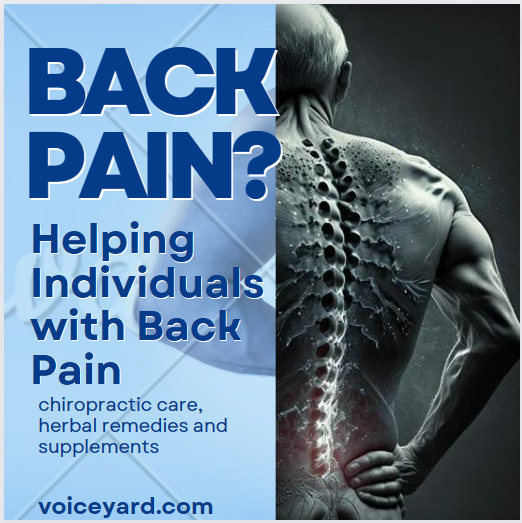Managing Back Pain: Understanding Causes, Treatment Options, and Lifestyle Changes
***freeDIGIBOOK***Women’s Health and Wellness: A Comprehensive Guide
Chapter 1: Introduction to Back Pain
Definition of back pain
Common causes of back pain
Risk factors for back pain
Back pain is a common complaint that affects millions of people worldwide. It can range from mild discomfort to debilitating pain that interferes with daily activities. In this chapter, we will discuss the definition of back pain, common causes, and risk factors associated with back pain.
Definition of Back Pain:
Back pain is a condition that causes discomfort or pain in the upper, middle, or lower back. It can be acute or chronic, and can range from mild to severe. Acute back pain lasts for a few days or weeks, while chronic back pain persists for longer than three months.
Common Causes of Back Pain:
Back pain can be caused by a variety of factors, including:
Muscle or ligament strain: This is one of the most common causes of back pain, and can be caused by lifting heavy objects, sudden movements, or poor posture.
Bulging or ruptured discs: Discs are the soft cushions between the vertebrae in the spine. When a disc bulges or ruptures, it can put pressure on the nerves in the spine, causing pain.
Arthritis: Arthritis is a condition that causes inflammation in the joints, including those in the spine. This can lead to back pain.
Osteoporosis: Osteoporosis is a condition that causes the bones to become weak and brittle, which can lead to fractures in the spine and back pain.
Spinal stenosis: Spinal stenosis is a condition that causes the spinal canal to narrow, putting pressure on the nerves in the spine and causing pain.
Risk Factors for Back Pain:
Several factors can increase the risk of developing back pain, including:
Age: Back pain is more common as we get older, as the spine begins to degenerate over time.
Obesity: Excess weight can put pressure on the spine and increase the risk of back pain.
Poor posture: Sitting or standing for long periods in poor posture can strain the muscles and lead to back pain.
Sedentary lifestyle: Lack of physical activity can weaken the muscles in the back and increase the risk of back pain.
Smoking: Smoking can increase the risk of back pain by reducing blood flow to the spine.
Understanding the common causes and risk factors associated with back pain is the first step in preventing and managing this condition. In the next chapter, we will discuss the anatomy of the spine and how it can contribute to back pain.
Chapter 2: Anatomy of the Spine
Overview of the spine and its components
How the spine is structured and functions
How the spine can contribute to back pain
The spine is a complex structure made up of bones, muscles, ligaments, and nerves. In this chapter, we will discuss the components of the spine, how it is structured and functions, and how it can contribute to back pain.
Overview of the Spine and its Components:
The spine, also known as the vertebral column, is composed of 33 vertebrae that are stacked on top of each other. The vertebrae are divided into five regions: cervical (neck), thoracic (upper back), lumbar (lower back), sacral (pelvic region), and coccygeal (tailbone). The cervical region has 7 vertebrae, the thoracic region has 12, the lumbar region has 5, and the sacral and coccygeal regions are fused and have 9 vertebrae combined.
Between each vertebra are soft discs that act as shock absorbers and help cushion the spine. The spine is also supported by muscles and ligaments, which help maintain proper alignment and movement.
How the Spine is Structured and Functions:
The spine is designed to protect the spinal cord, which is a bundle of nerves that carries messages from the brain to the rest of the body. The spinal cord runs through a canal in the center of the vertebrae.
The spine is also responsible for supporting the weight of the upper body and allowing for movement. The vertebrae are connected by facet joints, which allow for bending and twisting of the spine.
How the Spine Can Contribute to Back Pain:
The complex structure of the spine makes it susceptible to injury and pain. Back pain can be caused by problems with any of the components of the spine, including the vertebrae, discs, muscles, ligaments, and nerves.
For example, a herniated disc can put pressure on the nerves in the spine, causing pain. Muscle strains and ligament sprains can also cause pain in the back.
Poor posture and body mechanics can also contribute to back pain. Slouching, standing or sitting for long periods, and improper lifting techniques can all strain the muscles and ligaments in the back, leading to pain.
Understanding the anatomy of the spine and how it functions can help individuals better understand the causes of back pain and how to prevent and manage it. In the next chapter, we will discuss the different types of back pain and how they can be treated.
Chapter 3: Types of Back Pain
Acute vs. chronic back pain
Lower back pain vs. upper back pain
Back pain with nerve involvement
Back pain can manifest in different ways depending on the cause and severity of the condition. In this chapter, we will discuss the different types of back pain, including acute vs. chronic back pain, lower back pain vs. upper back pain, and back pain with nerve involvement.
Acute vs. Chronic Back Pain:
Acute back pain refers to pain that lasts for a few days or weeks and typically occurs after an injury or strain. This type of back pain usually goes away on its own with rest, ice or heat therapy, and pain medication.
Chronic back pain, on the other hand, lasts for longer than three months and can be caused by an underlying medical condition such as arthritis, osteoporosis, or a herniated disc. Chronic back pain can be more difficult to manage and may require more aggressive treatment options such as physical therapy, medications, or surgery.
Lower Back Pain vs. Upper Back Pain:
Lower back pain is the most common type of back pain and is often caused by muscle strain, ligament sprain, or injury to the discs between the vertebrae. This type of pain can range from mild to severe and can be accompanied by stiffness, limited range of motion, and muscle spasms.
Upper back pain, also known as thoracic back pain, is less common and is typically caused by poor posture, trauma, or degenerative conditions. This type of pain can also range from mild to severe and can be accompanied by a burning or aching sensation.
Back Pain with Nerve Involvement:
Back pain with nerve involvement, also known as radicular pain, is caused by compression or irritation of a nerve root in the spine. This type of pain can be sharp, shooting, or burning and can radiate down the leg or arm.
Common causes of nerve-related back pain include herniated discs, spinal stenosis, and degenerative disc disease. Treatment options for this type of pain may include medications, physical therapy, or surgery.
Understanding the different types of back pain and their causes is important in developing an effective treatment plan. In the next chapter, we will discuss the diagnostic process for back pain, including medical history, physical examination, and imaging tests.
Chapter 4: Diagnosing Back Pain
Medical history and physical exam
Diagnostic imaging (X-rays, CT scans, MRI)
Other tests and procedures
Diagnosing the cause of back pain is crucial in developing an effective treatment plan. In this chapter, we will discuss the diagnostic process for back pain, which includes taking a medical history, performing a physical examination, and utilizing imaging tests and other procedures.
Medical History and Physical Exam:
The first step in diagnosing back pain is taking a detailed medical history. The healthcare provider will ask about the duration and severity of the pain, as well as any other symptoms such as numbness, tingling, or weakness in the extremities.
The healthcare provider will also perform a physical exam, which may include evaluating range of motion, muscle strength, and reflexes. They may also look for signs of inflammation or injury, such as swelling or bruising.
Diagnostic Imaging:
If the medical history and physical exam suggest an underlying medical condition, the healthcare provider may order imaging tests to confirm the diagnosis. These tests may include:
X-rays: X-rays can provide images of the bones in the spine and can help identify fractures, tumors, or degenerative changes.
CT scans: CT scans can provide more detailed images of the spine and can help identify herniated discs or other soft tissue abnormalities.
MRI: MRI scans use powerful magnets and radio waves to create detailed images of the soft tissues in the spine, including the discs, nerves, and muscles.
Bone scans: Bone scans can help identify areas of bone damage or inflammation, such as in cases of osteoporosis or arthritis.
Other Tests and Procedures:
In some cases, additional tests and procedures may be necessary to diagnose the cause of back pain. These may include:
Electromyography (EMG): EMG tests measure electrical activity in the muscles and nerves to help identify nerve-related problems.
Discography: Discography involves injecting a dye into the discs in the spine to identify the source of pain.
Blood tests: Blood tests can help identify underlying medical conditions that may be causing back pain, such as infections or autoimmune disorders.
By utilizing a combination of medical history, physical exam, and imaging tests, healthcare providers can accurately diagnose the cause of back pain and develop an effective treatment plan. In the next chapter, we will discuss non-surgical treatment options for back pain.
Chapter 5: Non-surgical Treatments for Back Pain
Pain management techniques (ice/heat therapy, massage, acupuncture, etc.)
Medications for back pain (NSAIDs, muscle relaxants, etc.)
Physical therapy and rehabilitation
Non-surgical treatment options for back pain are typically the first line of defense for managing pain and promoting healing. In this chapter, we will discuss pain management techniques, medications for back pain, and physical therapy and rehabilitation.
Pain Management Techniques:
Ice and heat therapy: Applying ice or heat to the affected area can help reduce inflammation and alleviate pain.
Massage therapy: Massage can help relieve muscle tension and promote relaxation, reducing pain and improving range of motion.
Acupuncture: Acupuncture involves the insertion of small needles into specific points on the body, which can help relieve pain and promote healing.
Chiropractic care: Chiropractic adjustments can help realign the spine and relieve pressure on the nerves, reducing pain and promoting healing.
Medications for Back Pain:
Nonsteroidal anti-inflammatory drugs (NSAIDs): NSAIDs such as ibuprofen or naproxen can help reduce inflammation and relieve pain.
Muscle relaxants: Muscle relaxants can help alleviate muscle spasms and reduce pain.
Topical medications: Topical medications such as creams or patches can be applied directly to the skin and can help reduce pain and inflammation.
Physical Therapy and Rehabilitation:
Physical therapy and rehabilitation are important components of non-surgical treatment for back pain. These treatments can help improve range of motion, reduce pain, and promote healing. Physical therapy may include exercises, stretches, and other modalities to strengthen the muscles in the back and improve posture.
Other non-surgical treatments for back pain may include spinal decompression therapy, ultrasound therapy, or electrical stimulation therapy. These treatments can help reduce pressure on the nerves and promote healing.
In some cases, a combination of non-surgical treatments may be used to manage back pain. If non-surgical treatments are not effective, surgical options may be considered. In the next chapter, we will discuss surgical treatments for back pain.
Chapter 6: Surgical Treatments for Back Pain
Types of back surgery (discectomy, laminectomy, spinal fusion, etc.)
Risks and benefits of surgery
Postoperative recovery and rehabilitation
While non-surgical treatments are typically the first line of defense for managing back pain, surgery may be necessary for more severe or persistent cases. In this chapter, we will discuss the types of back surgery, the risks and benefits of surgery, and postoperative recovery and rehabilitation.
Types of Back Surgery:
Discectomy: This surgery involves removing a portion of a herniated disc that is putting pressure on a nerve.
Laminectomy: This surgery involves removing the back part of one or more vertebrae to relieve pressure on the nerves.
Spinal fusion: This surgery involves fusing two or more vertebrae together to stabilize the spine and reduce pain.
Artificial disc replacement: This surgery involves removing a damaged disc and replacing it with an artificial disc.
Risks and Benefits of Surgery:
As with any surgery, there are risks and benefits associated with back surgery. The benefits of surgery may include:
Reduced pain and improved function
Improved quality of life
Decreased need for pain medication
However, there are also risks associated with back surgery, including:
Infection
Bleeding
Nerve damage
Failure to relieve pain
The decision to undergo back surgery should be made in consultation with a healthcare provider, and the risks and benefits of the procedure should be carefully weighed.
Postoperative Recovery and Rehabilitation:
After back surgery, a period of recovery and rehabilitation is typically necessary. This may include:
Pain management: Pain medication may be prescribed to manage pain during the recovery process.
Physical therapy: Physical therapy may be recommended to improve range of motion, strength, and flexibility.
Activity modification: Patients may need to modify their activities and avoid heavy lifting or strenuous exercise during the recovery period.
It is important to follow postoperative instructions carefully and attend all follow-up appointments with the healthcare provider to ensure a successful recovery.
In summary, surgical treatments for back pain may be necessary in some cases, and the risks and benefits should be carefully considered. Recovery and rehabilitation are important components of the postoperative process. In the next chapter, we will discuss lifestyle modifications and prevention strategies for back pain.
Chapter 7: Lifestyle Changes to Prevent and Manage Back Pain
Exercises for back pain relief and prevention
Ergonomic adjustments to work and home environments
Diet and nutrition for back health
In addition to medical treatments for back pain, lifestyle changes can also play a role in preventing and managing back pain. In this chapter, we will discuss exercises for back pain relief and prevention, ergonomic adjustments to work and home environments, and diet and nutrition for back health.
Exercises for Back Pain Relief and Prevention:
Regular exercise can help strengthen the muscles in the back, improve posture, and prevent back pain. Exercises that are gentle on the back, such as walking, swimming, and yoga, can be beneficial. Strengthening exercises, such as planks and bridges, can help build core strength to support the spine.
Stretching can also be helpful for relieving back pain and improving flexibility. Gentle stretches such as hamstring stretches and hip flexor stretches can help alleviate tension in the back.
Ergonomic Adjustments to Work and Home Environments:
Making ergonomic adjustments to work and home environments can also help prevent and manage back pain. This may include:
Using a supportive chair with proper lumbar support and adjustable height
Positioning the computer monitor at eye level
Using a headset for phone calls to avoid neck strain
Avoiding prolonged periods of sitting or standing
Diet and Nutrition for Back Health:
A healthy diet can also play a role in preventing and managing back pain. A diet rich in fruits, vegetables, whole grains, and lean protein can help maintain a healthy weight and reduce inflammation in the body. Adequate hydration is also important for maintaining spinal health.
Certain nutrients, such as calcium and vitamin D, are important for bone health and can help prevent conditions such as osteoporosis, which can contribute to back pain.
Incorporating these lifestyle changes into daily routines can help prevent and manage back pain. It is important to consult with a healthcare provider before starting a new exercise or dietary regimen. In the next chapter, we will discuss complementary and alternative therapies for back pain.
Chapter 8: Back Pain in Specific Populations
Back pain in athletes and active individuals
Back pain in pregnant women
Back pain in older adults
Back pain can affect people of all ages and lifestyles, but certain populations may be more susceptible to certain types of back pain. In this chapter, we will discuss back pain in athletes and active individuals, back pain in pregnant women, and back pain in older adults.
Back Pain in Athletes and Active Individuals:
Athletes and active individuals may be at higher risk for back pain due to the repetitive stress and strain placed on the back during physical activity. Common types of back pain in this population include muscle strains, ligament sprains, and stress fractures.
Preventive measures for back pain in athletes and active individuals include proper warm-up and stretching before activity, using proper technique during exercises and sports, and maintaining a healthy weight to reduce pressure on the back.
If back pain does occur, rest, ice, and over-the-counter pain medications may be recommended. In some cases, physical therapy or chiropractic care may also be beneficial.
Back Pain in Pregnant Women:
Pregnancy can put significant strain on the back, leading to back pain. This is due to the weight gain and changes in posture and balance that occur during pregnancy. Common types of back pain in pregnant women include sciatica and low back pain.
Preventive measures for back pain in pregnant women include maintaining good posture, avoiding high heels, and using proper lifting techniques. Exercise programs specifically designed for pregnant women, such as prenatal yoga or swimming, can also help relieve back pain.
If back pain does occur, rest, ice, and over-the-counter pain medications may be recommended. In some cases, physical therapy or chiropractic care may also be beneficial. It is important to consult with a healthcare provider before starting any new treatment during pregnancy.
Back Pain in Older Adults:
Back pain is a common problem in older adults due to age-related changes in the spine, such as degenerative disc disease or spinal stenosis. Other conditions that can contribute to back pain in older adults include osteoporosis and arthritis.
Preventive measures for back pain in older adults include maintaining a healthy weight, staying active with low-impact exercises such as walking or swimming, and using proper posture and body mechanics.
Treatment options for back pain in older adults may include medications, physical therapy, or surgery, depending on the underlying cause and severity of the pain.
In summary, back pain can affect people of all ages and lifestyles, and certain populations may be more susceptible to certain types of back pain. It is important to consult with a healthcare provider to determine the best course of treatment for back pain. In the next chapter, we will discuss complementary and alternative therapies for back pain.
Chapter 9: Complementary and Alternative Medicine for Back Pain
Chiropractic care
Herbal remedies and supplements
Other alternative therapies (yoga, Pilates, etc.)
In addition to traditional medical treatments, complementary and alternative medicine (CAM) may also be used to manage back pain. In this chapter, we will discuss chiropractic care, herbal remedies and supplements, and other alternative therapies such as yoga and Pilates.
Chiropractic Care:
Chiropractic care involves the manipulation of the spine to relieve pressure on the nerves and alleviate back pain. Chiropractors use their hands or specialized tools to apply controlled force to the spine, realigning the vertebrae and reducing pain.
Research on the effectiveness of chiropractic care for back pain is mixed, but many patients report significant pain relief after chiropractic treatments. It is important to choose a licensed and experienced chiropractor and to consult with a healthcare provider before starting chiropractic care.
Herbal Remedies and Supplements:
Certain herbal remedies and supplements may be beneficial for managing back pain. These may include:
Turmeric: Turmeric has anti-inflammatory properties and may help reduce back pain.
Omega-3 fatty acids: Omega-3s have anti-inflammatory properties and may help reduce back pain.
It is important to consult with a healthcare provider before starting any new herbal remedies or supplements, as some may interact with medications or have potential side effects.
Other Alternative Therapies:
Other alternative therapies for back pain include yoga, Pilates, and acupuncture. Yoga and Pilates can help improve posture and strengthen the muscles in the back, reducing pain and improving range of motion. Acupuncture involves the insertion of small needles into specific points on the body, which can help relieve pain and promote healing.
It is important to consult with a healthcare provider before starting any new alternative therapy, as some may not be appropriate for certain individuals or may have potential risks.
In summary, complementary and alternative medicine may be used to manage back pain in addition to traditional medical treatments. It is important to consult with a healthcare provider before starting any new therapy or supplement.
Chapter 10: Living with Back Pain
Coping strategies for chronic back pain
Mental health and emotional impact of back pain
Resources for individuals with back pain (support groups, advocacy organizations, etc.)
By exploring the causes, diagnosis, and treatment options for back pain, individuals can better understand their condition and take an active role in managing their symptoms and improving their quality of life.
Back pain can have a significant impact on an individual’s quality of life, especially for those with chronic pain. In this chapter, we will discuss coping strategies for chronic back pain, the mental health and emotional impact of back pain, and resources for individuals with back pain.
Coping Strategies for Chronic Back Pain:
Living with chronic back pain can be challenging, and it is important to develop coping strategies to manage symptoms and maintain a good quality of life. Some coping strategies may include:
Relaxation techniques, such as deep breathing or meditation, to reduce stress and tension in the body.
Pacing activities to avoid overexertion and prevent exacerbation of symptoms.
Maintaining a positive attitude and focusing on what is still possible despite limitations.
Mental Health and Emotional Impact of Back Pain:
Back pain can also have a significant impact on mental health and emotional well-being. Chronic pain can lead to depression, anxiety, and social isolation. It is important to address these emotional and psychological issues in addition to physical symptoms.
Resources for Individuals with Back Pain:
There are many resources available for individuals with back pain, including support groups, advocacy organizations, and educational resources. These resources can provide emotional support, education about treatment options, and advocacy for better access to care.
Examples of resources include the American Chronic Pain Association, the National Institute of Neurological Disorders and Stroke, and the Spine Health Institute.
In summary, living with back pain can be challenging, but there are coping strategies and resources available to help individuals manage their symptoms and improve their quality of life. It is important to address the physical, emotional, and psychological aspects of back pain to achieve optimal well-being.





Great amazing things here. I?¦m very satisfied to see your article. Thank you a lot and i am having a look ahead to contact you. Will you kindly drop me a mail?
I enjoy your writing style really enjoying this site.